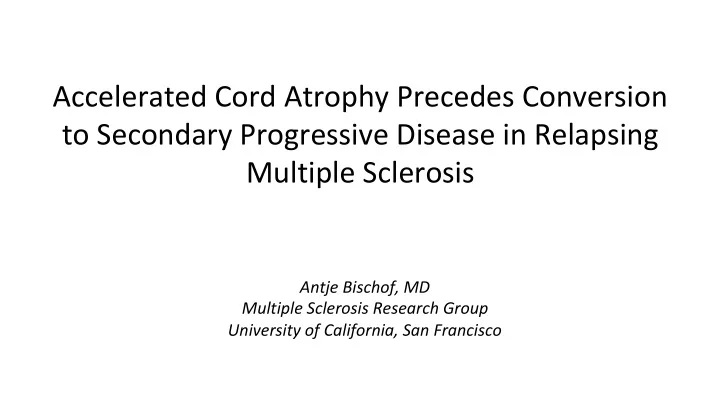

Accelerated Cord Atrophy Precedes Conversion to Secondary Progressive Disease in Relapsing Multiple Sclerosis Antje Bischof, MD Multiple Sclerosis Research Group University of California, San Francisco
Background • Understanding of progressive disease major challenge in multiple sclerosis (MS) research • MRI measures might provide useful surrogates of disease progression and disability • Among all radiographic measures, spinal cord area shows the strongest correlations with MS disability and discriminates progressive from relapsing-remitting (RR) disease subtypes.
Study Design Participants: • 54 RRMS patients who converted to SPMS during the 12-year observation period (RR → SP) – 54 matching RRMS patients (sex, age, disease duration, EDSS) who remained RRMS during the – observation period (RR → RR) 54 age- and sex-matched healthy controls at study baseline (CTRL) – Main Outcomes • Baseline and annual change during the pre-conversion period): Spinal cord area at C1 level – Brain T1, T2 lesion load – Brain volumes: – Global: Regional: - Whole brain - Thalamus - White matter - Caudate nucleus - Gray matter - Putamen - Ventricular Volume
Spinal cord area measurement at C1 level on T1-w brain images
Results: Baseline Characteristics Characteristics Level CTRL (n=54) RR → RR (n=54) RR → SP (n=54) p Baseline Sex F 32 (59) 32 (59) 32 (59) M 22 (41) 22 (41) 22 (41) Age * 44 (14) 49 (15 · 3) 47 (14 · 5) 0 · 191 Disease Duration ** - 10 (14 · 3) 12 (14 · 0) 0 · 995 EDSS ** - 1 · 5 (1 · 5) 2 · 5 (1 · 5) 0 · 0002 MSSS ** - 1 · 5 (2 · 5) 2 · 6 (3 · 5) 0 · 002 Conversion Age ** F - - 54 (12) M - - 52 (14) 0 · 208 Disease Duration ** F - - 19 (11) M - - 15 (9) 0 · 096 Treatment † Naïve - 10 (19) 5 (9) Low - 35 (65) 35 (65) Intermediate - 3 (6) 4 (7) High - 6 (11) 10 (19) 0 · 104 Differences were analysed using * Kruskal-Wallis, ** Wilcoxon rank sum, or † Chi-square tests.
Annualized cord atrophy rates discriminate between the matched groups pre-conversion RR → RR group: -0.74%/year Group RR RR RR → SP group: -2.15%/year 110 RR SP Measureable up to 4 years before 105 conversion to SPMS 100 C1A (mm2) No effect of 95 - Relapse rate - Disease duration 90 - New/enlarging lesions 85 - Disease-modifying treatments - Slowly enlarging lesions 80 p <0.0001* 0 2 4 6 8 10 12 14 Time from MRI Baseline (years) *using a mixed-effects model with adjustment for age and sex
Baseline Brain Volumes are lower in patients, but do not differentiate between the two patient groups WBV GMV WMV cGMV 1510 740 775 630 1500 770 625 730 1490 765 620 1480 760 615 720 1470 755 610 1460 750 710 605 1450 745 600 1440 740 700 595 1430 735 Based on least squares regression analyses, *** ** *** ** 590 1420 730 690 *** ** *** ** adjusted for age and sex Brain Volumes (cc) RR RR RR SP CTRL * p ≤ 0 · 05, VV Thalamus Caudate Putamen ** p ≤ 0 · 005, ** p ≤ 0 · 0001 23.0 14.0 10.0 30 22.5 13.5 22.0 9.5 25 21.5 13.0 21.0 9.0 20 20.5 12.5 20.0 8.5 15 *** *** * *** 19.5 ** *** *** 12.0 ***
Conclusions • Cervical cord atrophy (C1 level), obtained from routine brain MRI, is a strong indicator of impending conversion to SPMS Brain measures, including T1 and T2 lesion volumes, and regional and global brain • volumes at baseline and over time do not discriminate course compared to those who did not Could be useful • – To study the role of genetic, epidemiologic and immune variables on MS – To measure the long-term impact of treatment in clinical trials – For early stratification of patients at risk for severe disability to guide individualized treatment decisions – Retrospective analysis of large number of legacy brain scans worldwide acquired in clinical trials and observational MS cohort studies
Recommend
More recommend